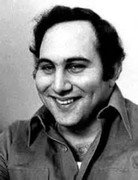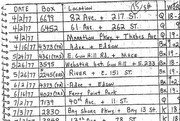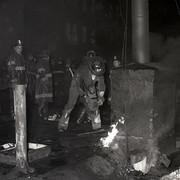E 248 would receive a "care package" from Ebinger's six days a week. At the end of the 3 x 6 tour, one firefighter would walk two blocks to the bakery and come back with as much as he could carry. Each night, knowing fresh goods were coming in the morning, we would put bakery items on the rig and pass them out to others in the Battalion as we had runs.
You are using an out of date browser. It may not display this or other websites correctly.
You should upgrade or use an alternative browser.
You should upgrade or use an alternative browser.
My younger Buff years
- Thread starter nfd2004
- Start date
- Joined
- Apr 1, 2007
- Messages
- 4,307
Ebingers was absolutely the best bakery that ever existed. My family lived w . . .a . . .y . . .y out in Nassau County (East Rockaway). Every holiday we had a family get together at my aunt's house around the corner, and my two spinster cousins from Brooklyn would bring dessert . . . and it was ALWAYS from Ebingers. I lived for those cakes, and was tickled to death when Ebingers finally opened a store nearby in Rockville Centre. I've been around the world since, and have eaten in many fine restaurants . . . but I can still taste those cakes from Ebingers, and they haven't been beaten yet.
Ebinger's was founded in Flatbush in 1898 by George and Catherine Ebinger. They grew famous for their cakes and pies, and especially their Blackout Cake. They grew to be a chain of quality bake shops across the boro.
Named for wartime blackouts, their famous and chocolate-pudding-filled "Blackout Cake" was a chocolate layer cake filled and frosted with dark fudge and dusted with chocolate cake crumbs
The many changes in Brooklyn in the late 60s and early 70s forced hard times for many merchants and shops and they closed in bankruptcy on August 26, 1972.
There was an effort to revive the bakery brand in 1979 under the name "Ebinger's". It did not suceed but rights were sold to another successful chain - "Entenmanns". .

Blackout Cake

Named for WWII blackouts
Named for wartime blackouts, their famous and chocolate-pudding-filled "Blackout Cake" was a chocolate layer cake filled and frosted with dark fudge and dusted with chocolate cake crumbs
The many changes in Brooklyn in the late 60s and early 70s forced hard times for many merchants and shops and they closed in bankruptcy on August 26, 1972.
There was an effort to revive the bakery brand in 1979 under the name "Ebinger's". It did not suceed but rights were sold to another successful chain - "Entenmanns". .

Blackout Cake

Named for WWII blackouts
- Joined
- Jun 27, 2007
- Messages
- 3,722
Entemann's was brought out by Bimbo's. They dis-continued the "Black-out Cake".
68jk09 said:nfd....i regard to reply # 1358 .....in the '70s the FDNY/NEW YORK STATE EMT patch was worn on the right sleeve of the turnout coat & a small STAR OF LIFE sticker was worn on the rear left panel of the Helmet providing ID from either side.
Thanks Chief JK, I appreciate that. I remember seeing the patch and the Star of Life sticker being wore, but I thought it was just the guys putting it on their gear. I never knew there was an assigned area for this to be displayed. It makes perfect sense to me.
- Joined
- May 22, 2009
- Messages
- 286
Back in late 68 Aviation Volunteers added an ambulance service to the Department. After a brief intrnal set up operational guidelines we trained 8 of
the firefighters and 12 women as state EMT's to staff the ambulance for emergncy calls. Back then you needed to first complete ARC standard and
advanced firstaid, AHA CPR, emergency child birth and vehicle extrication.. Once completd you could now attend the EMT program which for our
group was held at Jacobi Hospital for the practical training and lecture sessions were held at coop city.
the firefighters and 12 women as state EMT's to staff the ambulance for emergncy calls. Back then you needed to first complete ARC standard and
advanced firstaid, AHA CPR, emergency child birth and vehicle extrication.. Once completd you could now attend the EMT program which for our
group was held at Jacobi Hospital for the practical training and lecture sessions were held at coop city.
Decade of Fire - documentary why the Bronx burned by community member:
http://www.kickstarter.com/projects/2109579378/decade-of-fire-how-the-south-bronx-was-burned
http://www.kickstarter.com/projects/2109579378/decade-of-fire-how-the-south-bronx-was-burned
mack said:Decade of Fire - documentary why the Bronx burned by community member:
http://www.kickstarter.com/projects/2109579378/decade-of-fire-how-the-south-bronx-was-burned
"mack" Thank you very much for posting the info on that documentary. Of course looking at that video now, it's hard to believe how bad things really were then. From the quarters of Manhattans Eng 54/Lad 4, in the World Famous Times Sq area, to the South Bronx quarters of Eng 82/Lad 31, where this video is all focused, is only 9 miles apart. "From the heartbeat of the world to worlds worst ghetto". Only a few short miles from Fame, Luxury, and Money, to Poverty, Crime, Drugs and Arson. Two different worlds just a few miles apart.
This video and their web site perserves what many on here have described. A place where fires were a routine daily part of life. Two Presidents walked these streets among the burned out rubble. I doubt they ever saw anything else like it either. It's still hard to believe it ever happened. As a buff, I was there, but not every day. I have friends that were with me and we still talk about it. But how do you explain to somebody who wasn't there what it was like. Thanks to "mack" posting this video, it does help.
The story of the FDNY War Years is that it was "allowed" to happen, and "allowed" is what it was. How many times I have written about Gasoline Gomez who would hit every 10 days or so Charlotte Street area. His first tease fire around 2000 in a vacant or partially vacant 1st floor rear room. Then his second tease fire 2300 same or near by building 1st floor rear room. Then 0300 he would have 3 or 4 floors going rear of same or near by building, always the rear so we couldn't use the towers. Every time and every fire the 10-41 ( arson marshal notification) signal was transmitted, nothing, never any marshal response. No calls to qtrs., no marshal visits, nothing. This went on for over a year or so. Really, how hard would it have been to have some marshals on the roof of a Charlotte Street building to wait for the guy with the gasoline can walking down the empty streets around 0300. So many bothers went out with LOD injuries, so many with short retirements. Finally the good Lord stepped in and Gomez blew himself out a window, lived, but that was the end of him. May he have suffered every day for the rest of his life. The Soundview area of the Bronx, 950+ residential and commercial buildings in 1970, only 30 or so left in 1980.My busy boxes during my years 2323, Cauldwell and 160 and 2743 Charlotte and 170, both a mile or so from Park Avenue in the Bronx. Question. Does anyone believe that the city would have allowed 3rd Ave. area and 60th and 5th Ave. and 70th off of Park Ave. in Manhattan to be burned out in 1973? Does anyone believe that they would have allowed 900 buildings to be burned down in the West Village in Manhattan in 1975? Of course not. Then why did they allow it to happen to the people living on Cauldwell Ave., Charlotte Street and in the Soundview area of the Bronx? The only ones who cared were the people who lived there, and the fire fighters and their families who paid a such huge personal price.
I've written enough about it, best to just leave it be from now on. Was, the best of times, seeing men at their best, and the worst of times, seeing men at their worst.
I've written enough about it, best to just leave it be from now on. Was, the best of times, seeing men at their best, and the worst of times, seeing men at their worst.
Thanks Chief.
"Gasoline Gomez Legendary Arsonist of the Bronx" - Village Voice 1975:
http://news.google.com/newspapers?nid=1299&dat=19750623&id=8tNHAAAAIBAJ&sjid=Q4wDAAAAIBAJ&pg=6049,6736815
"Gasoline Gomez Legendary Arsonist of the Bronx" - Village Voice 1975:
http://news.google.com/newspapers?nid=1299&dat=19750623&id=8tNHAAAAIBAJ&sjid=Q4wDAAAAIBAJ&pg=6049,6736815
No one cared about anything in NYC in the 1970s.
Everyone knows David Berkowitz as the Son of Sam killer who terrorized NYC as a serial killer in the 1970s. When arrested, police found a log book with 1488 fires set in NYC between 1974 and 1977. He recorded box number, location, date, time, comments.
He confessed that he set over 2000 fires. He would set a fire and stay to watch the response and operations. And he was never identified as an arsonist or sought by investigators. 2000 fires, most in the same neighborhoods - and he was never identified as an arson suspect.
http://www.murderpedia.org/male.B/b/berkowitz-photos-2.htm
There were many, many more arsonists in NYC in the 1970s.

Son of Sam arson log sample:

Everyone knows David Berkowitz as the Son of Sam killer who terrorized NYC as a serial killer in the 1970s. When arrested, police found a log book with 1488 fires set in NYC between 1974 and 1977. He recorded box number, location, date, time, comments.
He confessed that he set over 2000 fires. He would set a fire and stay to watch the response and operations. And he was never identified as an arsonist or sought by investigators. 2000 fires, most in the same neighborhoods - and he was never identified as an arson suspect.
http://www.murderpedia.org/male.B/b/berkowitz-photos-2.htm
There were many, many more arsonists in NYC in the 1970s.

Son of Sam arson log sample:

Chief (*******). Very few of us, if any, can relate to what you and the members of the department did during those years.
I certainly appreciate you sharing your stories with us. You were a part of it along with those other members. I would personnelly like to Thank you for your contributions to this thread.
As a retired firefighter from a small city in Connecticut, I can NOT relate to what your job was like. Maybe the smoke and heat was the same, but the job really wasn't.
If there was ANY GOOD that came out of this terrible nightmare, I guess it was that we (buffs that got on the job) learned alot from what we saw you and the other members do. I have to say "We learned from the Best". Like yourself, most of us have retired from the job now. A few are getting ready to retire. Alot of us have passed on some of the things we learned just by watching. Many that we passed that onto are now Officers and Chiefs themselves. And they have passed it on too.
I believe that through all those dark clouds, hundreds and thousands of people have been helped because of what you and your Brother Firefighters have done. Not only did you help the thousands of people in the neighborhood that those FDNY members served, but also, indirectly, you helped many more in a few other cities that I know of. Buffs turned firefighters in places like Bridgeport, New London, Groton, Norwich, and Fairfield, Ct. A group of firefighters, some that are still on the job, but most have retired by now.
Thank you for all you and the members of your dept have taught us. Every one of us that watched you and the other FDNY members operate during those days, feel the same way.
I wish you a very happy and healthy retirement. Thank you for what you have done.
Bill Dennis (Retired Captain)
Norwich, Ct Fire Dept
I certainly appreciate you sharing your stories with us. You were a part of it along with those other members. I would personnelly like to Thank you for your contributions to this thread.
As a retired firefighter from a small city in Connecticut, I can NOT relate to what your job was like. Maybe the smoke and heat was the same, but the job really wasn't.
If there was ANY GOOD that came out of this terrible nightmare, I guess it was that we (buffs that got on the job) learned alot from what we saw you and the other members do. I have to say "We learned from the Best". Like yourself, most of us have retired from the job now. A few are getting ready to retire. Alot of us have passed on some of the things we learned just by watching. Many that we passed that onto are now Officers and Chiefs themselves. And they have passed it on too.
I believe that through all those dark clouds, hundreds and thousands of people have been helped because of what you and your Brother Firefighters have done. Not only did you help the thousands of people in the neighborhood that those FDNY members served, but also, indirectly, you helped many more in a few other cities that I know of. Buffs turned firefighters in places like Bridgeport, New London, Groton, Norwich, and Fairfield, Ct. A group of firefighters, some that are still on the job, but most have retired by now.
Thank you for all you and the members of your dept have taught us. Every one of us that watched you and the other FDNY members operate during those days, feel the same way.
I wish you a very happy and healthy retirement. Thank you for what you have done.
Bill Dennis (Retired Captain)
Norwich, Ct Fire Dept
During these War Years, the busiest firefighters in the World would come up with some very simple ideas to try and make their jobs easier. Things like cutting a truck tire tube to use as a large rubber band on their helmets. That band would hold a light and maybe a wooden door chock they cut from a piece of wood. Another idea was to make a sling to carry the can or the saw. A simple strap so that hands could be free to climb ladders etc.
These were some of the ideas that as a buff, we would pick up on. And when both my brother and I got on the job in the mid 70s we would use a few of these tricks. We both had the tire tubes holding a little plastic light and a home made door chock. We both made slings for the can and saw. It wasn't accepted by all at first, but once a few guys tried it out, they soon realized how much easier things were then. It was those FDNY War Years Firefighters that once again, through their experience came up with some great ideas.
I spent most of my time on an Engine Company, while my brother George, spent most of his time on a Truck Company. We both buffed the FDNY during those days. Because my brother George spent more time on a Truck Company, he got more of a chance to use the can/saw thing.
Recently I was talking to a member of this site who was a part of these busy years. Most of his career he operated as a member of a Truck Company. I was telling him this story of how we learned by watching and picking up a few tricks like carrying a saw on a sling. How much easier it made our jobs in Connecticut. I told him I remember seeing those guys climbing that aerial ladder, and sometimes it was almost straight up, carrying that saw on a sling. Yes, it certainly did make the job easier.
But what I didn't realize was that sometimes that had to be done four or five times a night. That changed my way of thinking. Not too many of use can relate to carrying a saw up an aerial ladder, sometimes fully extended, in full gear and air pack, numerous times a night. And then getting to the roof and going to work. But these War Years firefighters did it. Finding the strength at 5 am to carry a saw up to a roof after doing it three or four times earlier in the night was just part of the routine business of fighting fires during those years.
Now not to offend anyone, or my brother George (georged4997 on here), but a retired War Years member who spent most of his career on some very busy FDNY Engine Cos once told me why those ladder guys cut holes in roofs. He said; "Those Ladder guys cut holes in roofs so they can look down and watch the Engine guys put out the fires". I tend to agree with him.
These were some of the ideas that as a buff, we would pick up on. And when both my brother and I got on the job in the mid 70s we would use a few of these tricks. We both had the tire tubes holding a little plastic light and a home made door chock. We both made slings for the can and saw. It wasn't accepted by all at first, but once a few guys tried it out, they soon realized how much easier things were then. It was those FDNY War Years Firefighters that once again, through their experience came up with some great ideas.
I spent most of my time on an Engine Company, while my brother George, spent most of his time on a Truck Company. We both buffed the FDNY during those days. Because my brother George spent more time on a Truck Company, he got more of a chance to use the can/saw thing.
Recently I was talking to a member of this site who was a part of these busy years. Most of his career he operated as a member of a Truck Company. I was telling him this story of how we learned by watching and picking up a few tricks like carrying a saw on a sling. How much easier it made our jobs in Connecticut. I told him I remember seeing those guys climbing that aerial ladder, and sometimes it was almost straight up, carrying that saw on a sling. Yes, it certainly did make the job easier.
But what I didn't realize was that sometimes that had to be done four or five times a night. That changed my way of thinking. Not too many of use can relate to carrying a saw up an aerial ladder, sometimes fully extended, in full gear and air pack, numerous times a night. And then getting to the roof and going to work. But these War Years firefighters did it. Finding the strength at 5 am to carry a saw up to a roof after doing it three or four times earlier in the night was just part of the routine business of fighting fires during those years.
Now not to offend anyone, or my brother George (georged4997 on here), but a retired War Years member who spent most of his career on some very busy FDNY Engine Cos once told me why those ladder guys cut holes in roofs. He said; "Those Ladder guys cut holes in roofs so they can look down and watch the Engine guys put out the fires". I tend to agree with him.
There is an old saying that "a good truck makes a good engine." I was always, always, amazed with the trucks that I worked with during my time. At a top floor fire by the time I would get to the top floor within a minute I would hear the saw(s) working. By the time we had water and started in the vent hole had been cut and the windows were being taken. A good truck makes a good engine. At busy times and we went in alone, or the truck delayed, we could and would knock the fire down, but you always knew the difference working with a truck or without a truck.
A lot of "improvisation" came from busy days, many worked and became the norm, some didn't. Knee burns were a huge problem. No bunker gear then. I had a firefighter in 82 that received a very serious knee burn, was out for months. His first tour back he burned the same knee again, and was again out for months. On return he asked for a transfer, left for a much slower company. I was almost passed over for Captain as I had blood poisoning in my knee from a burn and was on medical leave the day before the promotion, was lucky to get full duty. At one point we tried to have our wives sew pot holders into the knee area of our pants. But the pot holders would get wet and hold any heat into you until you could cool the spot off. Interesting fire service days.
A lot of "improvisation" came from busy days, many worked and became the norm, some didn't. Knee burns were a huge problem. No bunker gear then. I had a firefighter in 82 that received a very serious knee burn, was out for months. His first tour back he burned the same knee again, and was again out for months. On return he asked for a transfer, left for a much slower company. I was almost passed over for Captain as I had blood poisoning in my knee from a burn and was on medical leave the day before the promotion, was lucky to get full duty. At one point we tried to have our wives sew pot holders into the knee area of our pants. But the pot holders would get wet and hold any heat into you until you could cool the spot off. Interesting fire service days.
******* Thanks for your thoughts, Chief. The knee burns reminds me of the rolled down rubber boots worn back then - mostly worn down. Even when pulled up, there was just a serious vulnerable area between turnout coat and boot. Thighs seemed to take a beating, too. Lot of burns behind the ears, necks, and wrists.
Also reminds me of all the guys who started to wear black, ankle-high, civilian work boots for better mobility, better support - especially truck guys. Technology did not progress with firefighter protection and individual safety needs.
Also reminds me of all the guys who started to wear black, ankle-high, civilian work boots for better mobility, better support - especially truck guys. Technology did not progress with firefighter protection and individual safety needs.
- Joined
- Aug 25, 2009
- Messages
- 28,575
******* Chief speaking of the old days Bill Knapp was at 73/42's Centennial on 9/10

